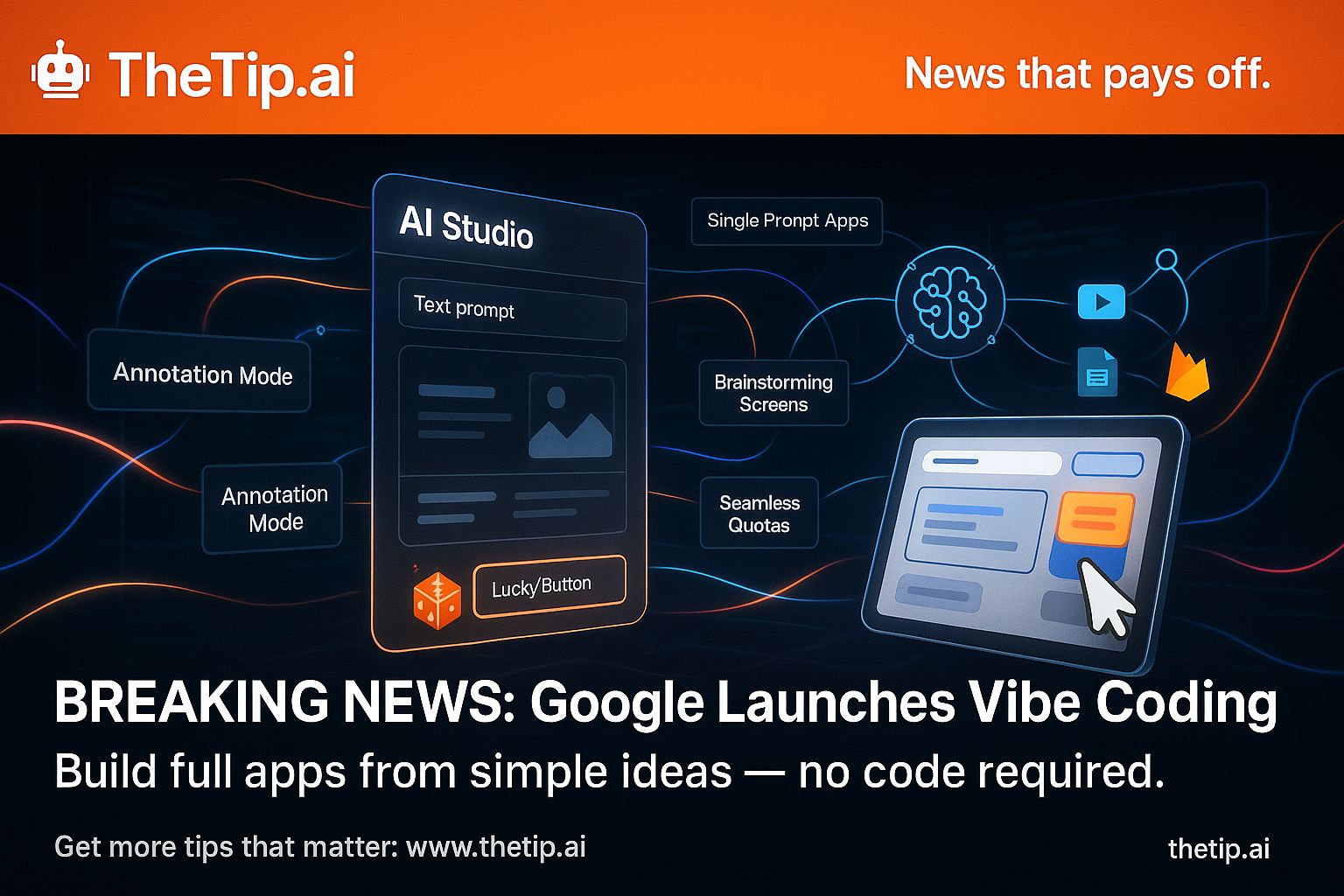- TheTip.AI - AI for Business Newsletter
- Posts
- Google introduces vibe coding transforming ideas into apps
Google introduces vibe coding transforming ideas into apps

Visual pointing replaces technical instruction writing
Hey AI Enthusiast,
Google just dropped vibe coding in AI Studio - turning ideas into working apps from descriptions alone after watching developers waste hours connecting different APIs and services manually.
You describe your multi-modal app vision, AI Studio wires Gemini models together automatically, handles API connections behind the scenes, and lets you point at elements to request changes instead of editing code line-by-line.
Let me break down today's power prompt and marketing strategy first (then show how no-code AI development changes how teams build prototypes for client pitches...)
🔥 Prompt of the Day 🔥
AI Podcast Show Notes Generator
Create One Automated Episode Summary System
Act as a podcast production specialist. Create one AI workflow for generating comprehensive show notes from [PODCAST EPISODES].
Essential Details:
Podcast Format: [INTERVIEW/SOLO/CO-HOSTED]
Episode Length: [AVERAGE DURATION]
AI Transcription: [TOOL USED]
SEO Importance: [RANKING PRIORITY]
Timestamp Needs: [HIGHLIGHT MARKERS]
Distribution Channels: [WHERE PUBLISHED]
Create one show notes workflow including:
Audio-to-text AI process
Key points extraction prompt
Timestamp generation rules
Guest bio AI summarization
SEO optimization checklist
Social snippet creation
Turn 2 hours into 15 minutes. Keep under 200 words total.
✅ Marketing Monday ✅
Marketing Automation Myths
Setting automation and forgetting it is marketing malpractice.
Your automated campaigns need constant nurturing to thrive while lazy setup guarantees mediocre results.
Here's what actually works:
Review automation performance weekly, not monthly.
Update messaging based on current events and trends.
Test new triggers and timing regularly.
Monitor where people drop off in sequences.
Keep refining based on real behavior data.
Automation amplifies strategy, not replaces it.
Generic sequences produce garbage output nobody reads or shares.
Most marketers waste automation potential feeding vague instructions expecting magic, yet output quality directly mirrors input detail while lazy setup guarantees mediocre results.
Automation engineering succeeds through systematic specificity implementation.
Feed context first then layer requirements methodically.
Critical for generating campaigns worth running rather than deleting immediately.
Define exact audience demographics before building anything else substantially.
Include sample outputs showing desired format and voice clearly.
Specify emotional responses you're targeting from recipients explicitly.
Document winning sequences creating your automation library systematically.
Test multiple variations tracking which versions perform strongest.
Never settle for first attempts - iteration reveals optimal structures.
Quality businesses document automation patterns like code repositories permanently.
Vagueness creates confusion whether human or machine generated.
Testing demonstrates specific sequences outperform generic requests exponentially.
Output tracking proves detailed instructions generate usable campaigns reliably.
Strategic automation libraries accelerate campaign production maintaining quality standards.
Precision investment returns exponential value through reusable frameworks.
Develop automation templates matching different campaign needs strategically.
Performance metrics show specificity drives engagement beyond generic approaches.
Systematic refinement transforms automation from toy into production tool effectively.
🤔 Did You Know? 🤔
AI-powered voice assistants can now detect lies during customer service calls by analyzing micro-tremors in speech patterns, helping companies identify fraudulent claims with 87% accuracy.
🗞️ Breaking AI News 🗞️
Google just dropped vibe coding in AI Studio - turning ideas into working apps from descriptions alone after watching developers waste hours connecting different APIs and services manually.
You describe your multi-modal app vision, AI Studio wires Gemini models together automatically, handles API connections behind the scenes, and lets you point at elements to request changes instead of editing code line-by-line.
Here's what actually shifted:
Single prompts generate complete applications - Describe your app concept and Studio assembles necessary capabilities instead of manually integrating separate services requiring authentication setup
Annotation Mode replaces code editing with visual pointing - Highlight interface elements and request modifications rather than writing technical instructions or digging through implementation details
App Gallery offers remixable project templates - Browse visual examples showcasing possibilities, preview functionality instantly, study starter patterns then adapt for specific needs
Brainstorming screens suggest ideas during build time - Loading moments cycle through context-aware concepts maintaining creative flow instead of displaying static progress indicators
Lucky button generates random starting points - Request automatic concept suggestions when inspiration stalls, eliminating blank canvas blocks that delay project starts
Seamless quota transitions maintain workflow continuity - Insert personal API keys when free limits hit then automatically revert after tier renewal without losing momentum
App creation fundamentally changed.
Google shipped basic Studio previously then rapidly evolved interaction patterns after feedback showed developers wanted simplified workflows over technical control.
Competitors lack integrated model orchestration and visual modification despite offering similar generation capabilities separately.
Vibe coding proves AI handles both initial creation and iterative refinement better than splitting these functions across disconnected platforms.
This demonstrates Studio's trajectory includes complete development cycles rather than limiting scope to initial prototyping alone.
Teams adopting natural language development early capture velocity advantages while others maintain fragmented toolchains requiring coordination overhead.

Over to You...
What app would you build first with vibe coding if you could describe it and watch it appear?
Hit reply and tell me.
To faster prototyping,

Sent to: {{email}} Jeff J Hunter, 3220 W Monte Vista Ave #105, Turlock, Don't want future emails? |
Reply